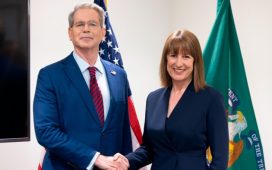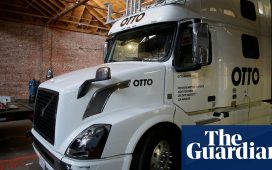SPECIAL REPORT: How Immigration Reforms Can Help Counter China

iStock illustration
This is part 3 of a 3-part special report on the health of the defense industrial base. Click here to download the full Vital Signs 2023 report.
China’s growing might and control over critical supply chains has prompted the United States to invest billions into “reshoring” the manufacturing of semiconductors and defense-related technologies.
To fill new high-tech jobs that investment will create, the United States must reform cumbersome immigration policies to bring in skilled foreign talent — it’s a matter of national security, according to defense, immigration and congressional experts.
The $280 billion CHIPS and Science Act of 2022 is projected to create 30,000 to 100,000 jobs, according to analyses by academic, industry and research organizations. Even with recent layoffs in the tech sector, there isn’t a standing supply of U.S. workers ready to jump into new semiconductor or defense manufacturing jobs, analysts say.
“We see that there’s a huge labor crunch,” said Jeremy Neufeld, a senior immigration fellow at the Institute for Progress. “Something like 80 percent of firms within the defense industrial base are reporting having a hard time filling job vacancies as it is.” And the shortage is more pronounced for sectors like semiconductors where much of the expertise is outside the United States, he added.
Neufeld and other experts say the United States needs to continue developing the domestic talent pool and get more Americans into science, technology, engineering and math fields, but that’s a longer-term endeavor that will take years to pay off.
“If we want to be serious about developing a workforce that can compete with China, we need to use whatever is in our toolbox,” Neufeld said. “I think both the immigration lever and the domestic training lever shouldn’t be thought of as totally separate, but they actually reinforce one another.”
That’s because building up industries like semiconductor manufacturing in the United States requires instruction and mentorship from the Taiwanese and South Koreans who are the leaders in the field, he said.
And to fill workforce gaps in the short run, the United States needs to tap more deeply into the global supply of high-skilled workers, he said.
“We’ve passed the CHIPS Act. We’re increasing our defense spending,” said Charles Wessner, who teaches global innovation policy at Georgetown and serves as an advisor to the Renewing American Innovation Program at the Center for Security and International Studies.
“We recognize the existential threat that China is posing to a rules-based system and to potentially our own safety. And we won’t bring in the people that we need to compete with them,” he said.
He and others noted that the United States has never been self-sufficient and has always immigrated, borrowed or poached the world’s science and technology talent.
“When we were desperately trying to do the Manhattan Project — and I think AI and quantum may be comparable — we didn’t say, ‘We can do this with Americans, we just have to train them and find them,’” he said. “We took the best minds we could find in the world and brought them together,” he said.
Richard Freeman, an economics professor at Harvard and research associate at the National Bureau of Economic Research, said the United States needs to look beyond the workforce implications and see high-skilled immigration through a national security lens.
For example, Chinese scientists are doing a lot of “cool stuff” with artificial intelligence, he said. Yet in recent years the United States has been discouraging potential students or scientists from China from coming to the United States.
“There’s got to be some thinking that if we’re going to do more of this stuff at home, we’re going to need more people, and that’s the time to also get the best people away from our competitors,” he said. “Let’s have them do their good stuff in the United States.”
For that matter, he and others argued that the United States should create a program to bring in Russian scientists who fled after Russia invaded Ukraine.
“I hope we have a scheme of how to turn those into our allies and friends … for national security,” he said. “It’s a notion [that] America is appealing in general … and we’ve got to think more about, how do we use that to undermine the bad guys?”
The current options for bringing foreign tech talent into the United States are limited to a few programs. Foreign students are welcome in U.S. universities, but once they complete their degrees, there are no easy paths for them to remain in the United States, Freeman noted. They have one to at most three years to find an employer willing to sponsor a visa.
The H-1B visa for skilled workers is capped at 65,000 slots per year, with another 20,000 available for immigrants who have earned an advanced degree in the United States. There is so much demand that the visas are awarded through a lottery rather than prioritizing the most needed or highest valued candidates.
So, while it would seem there would be compelling reasons to reform the H-1B system to bring in the best talent, there is strong opposition in Congress and provisions to increase visas for tech workers routinely get stripped from legislation like the CHIPS Act or annual defense bills, Neufeld said.
Opponents argue that giving out more visas increases the potential for espionage, drives down wages, crowds out domestic talent and reduces incentives for Americans to study STEM fields.
Experts who spoke with National Defense agreed those are demonstrated impacts of the current system.
“I think it’s important to be cognizant of the risk that Chinese nationals play,” Wessner said. “You can’t look for perfect … it’s not the world we’re going to find,” he added, noting that companies who hire foreign workers have strong incentives to monitor risk and prevent intellectual property theft.
Then there is the question of finding the right level of imported talent that meets workforce needs without crowding out citizens. That is almost impossible to calculate, Neufeld and Freeman said. There are some available data points such as the approximate size of the tech and defense workforces and the number of Americans who graduate with STEM degrees.
However, other than having tech employers raise wages until the potential pool of American workers is exhausted, there is no practical mechanism to determine how many of the nation’s STEM grads could be lured into tech jobs rather than positions in business or finance where they see more economic opportunity, they said.
“If we raise the pay, we can get more people from the United States. We can give more scholarships for fellowships or whatever we want, we can do that,” Freeman said.
But it isn’t a matter of a three to five percent increase in wages or in stipends for advanced degrees, it would take 20 to 40 percent more, he said. “That’s a pretty costly way for us to do it when … smart people really want to come here,” he continued.
The other constraint on determining the ideal immigration flow is that the H-1B system’s lottery structure doesn’t generate useful data on industry salaries and the level of need for different skill sets, Neufeld said.
“If for instance, the H-1Bs were allocated to the highest earners among the applicants, then you could look at what is the minimum wage that is getting an H-1B each year,” he said. “And if it’s going down and we’re getting less qualified workers each year, then that would be an argument for potentially lowering the cap.
“And if it’s going up drastically, that would be a real sign that there’s a significant shortage of visas and you could actually use that data to estimate the size of the increase,” he said. “It would give lawmakers better information about the effect on the margin of increasing the H-1B.”
Eliminating the lottery and prioritizing visas for high-paid/high-skilled workers is one measure in the “H-1B and L-1 Visa Reform Act” that Sen. Chuck Grassley, R-Iowa, and Sen. Richard Durbin, D-Ill., have been sponsoring the last few years. The bill seeks to protect wages and U.S. jobs by preventing outsourcing companies from abusing the lottery system and by prioritizing high-skilled immigrants in the H-1B pool.
“In the last Congress, the progressive caucus in the House … endorsed this idea of replacing the lottery and making sure that visas are going to the good-paying jobs,” Neufeld said, adding that he sees hope for passage in the new Congress. “It seems like the kind of thing that should have bipartisan support.”
Arun Seraphin, deputy director of the Emerging Technologies Institute at the National Defense Industrial Association, said while immigration is needed in the short- to medium-term to fill the gap, it shouldn’t be viewed as the “easy button” at the expense of continuing to invest in growing the domestic STEM workforce. That’s in part why he advocates for small-scale reforms.
“We’ve been trying for the last few years to do something based on this legislation called National Security Innovation Pathways,” he said.
That legislation “aims to establish a pathway to permanent residency for students and professionals engaged in fields such as artificial intelligence, quantum information sciences, biology, robotics, and hypersonics,” according to a 2020 press release from Rep. Elise Stefanik, R-N.Y.
The idea of the program is modeled on the Military Accessions Vital to National Interest program. That was designed to recruit legal immigrants with special skills — medical or language abilities — and fast-track their citizenship in exchange for military service.
The tech pathway program would start with 100 slots as a pilot to see if it works and could expand from there, he said.
“Every year, we’re getting closer, and we’re smoking out another objection and then addressing it,” he said. “And that’s why I’m hopeful that within the next few years, we will get a program like this going.”
Progress is also a result of “more and more people framing this as an anti-China national security issue,” he said. Still, the measure keeps getting caught up in committee politics and “the right wing-left wing crossfire,” over a comprehensive immigration package, he said.
That’s the problem with making progress on high-tech visa reform, Wessner said. “We’re not treating the issue with the urgency that it needs,” he said.
“We need to pull out this urgent need from the morass of family reunification and different quotas for different countries,” he said. “We just need to recognize the urgency that is there.”
Part 1: Annual Survey Shows Growing Worry Over Health of Industrial Base
Part 2: Defense Companies Face Post-Pandemic Workforce Shortages
Topics: Manufacturing, Industrial Base, International










